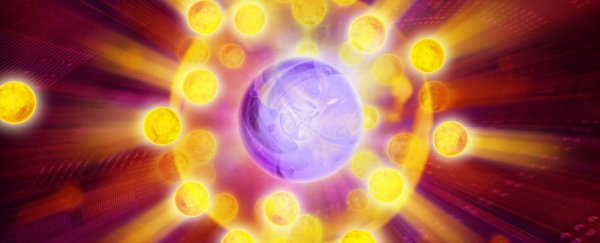For the first time, scientists have observed the formation of quasiparticles - a strange phenomenon observed in certain solids - in real time, something that physicists have been struggling to do for decades.
It's not just a big deal for the physics world - it's an achievement that could change the way we build ultra-fast electronics, and could lead to the development of quantum processors.
But what is a quasiparticle? Rather than being a physical particle, it's a concept used to describe some of the weird phenomena that happen in pretty fancy setups - specifically, many-body quantum systems, or solid-state materials.
An example is an electron moving through a solid. As it the electron travels, it generates polarisation in its environment because of its electrical charge. This 'polarisation' cloud follows the electron through the material, and together they can be described as a quasiparticle.
"You could picture it as a skier on a powder day," explained one of the researchers, Rudolf Grimm, from the University of Innsbruck in Austria. "The skier is surrounded by a cloud of snow crystals. Together they form a system that has different properties than the skier without the cloud."
Quasiparticles and their formation have been extensively described in theoretical models, but actually measuring and observing them in real time has been a real challenge. That's because not only is the quasiparticle phenomenon happening on a tiny scale - it's also incredible short-lived.
"These processes last only attoseconds, which makes a time-resolved observation of their formation extremely difficult," said Grimm.
To put that into perspective, 1 attosecond is one-quintillionth of a second. Which means 1 attosecond is to 1 second what 1 second is to about 31.71 billion years - so, yeah, that's pretty fast.
But the team managed to come up with a way to slow the process down a bit.
Inside a vacuum chamber, they used laser trapping techniques to create an ultracold quantum gas made up of lithium atoms and a small sample of potassium atoms in the centre.
They then used a magnetic field to tune interactions of the particles, creating a type of quasiparticle known as a Fermi polaron - which is basically potassium atoms embedded in a lithium cloud.
The formation of those quasiparticles would have taken on the order of 100 attoseconds in a normal system, but thanks to the ultracold quantum gas, the team was able to slow it down, and witness it happening for the first time ever.
"We simulated the same physical processes at much lower densities," said Grimm. "Here, the formation time for polarons is a few microseconds."
The goal now is to figure out how to not only observe these quasiparticles, but actually measure them, so that we can find a way to use them to develop quantum processing systems that will bring us the super-fast electronics of the future.
"We developed a new method for observing the 'birth' of a polaron virtually in real time," said Grimm. "This may turn out to be a very interesting approach to better understand the quantum physical properties of ultrafast electronic devices."
The research has been published in Science.
